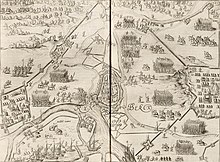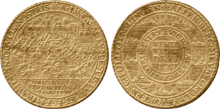Moritz of Orange's campaign of 1597
Moritz 'campaign of 1597 is the successful offensive that Prince Moritz of Orange and his army undertook against the Spaniards from August to November 1597. It became the most successful campaign that Moritz had undertaken in the Eighty Years' War .
Goal setting
With an army consisting of 1,200 cavalrymen and 7,000 foot soldiers, Moritz set out on August 1, 1597 in The Hague to strengthen the state-Dutch position on the Lower Rhine and in the western Münsterland. This was important from a strategic point of view because since the beginning of the Eighty Years' War the Dutch and Spaniards had been using the Lower Rhine area as a military base of operations and had occupied numerous cities for this purpose. Due to their own military weakness, the Rhenish territorial lords were unable to prevent the occupation of places on their territory by Spaniards or Dutch. The largest and strategically most important fortress of the Dutch, the Schenkenschanz, at the confluence of the Waal and Rhine rivers, was built in 1586 on the territory of the Duchy of Kleve .
course
The campaign began on the left Lower Rhine, in the immediate border area of the state or Spanish occupied places. Then the Dutch state army turned north and occupied places and fortified places in the western Münsterland.
Moritz von Orange first attacked Rheinberg, which was conquered by the Spanish in 1590. His goal was to make it more difficult for the Spaniards to cross the Rhine and thus to relocate troops to the area on the right bank of the Rhine. After the ten-day siege of Rheinberg from August 9th to 19th, the Spanish troops capitulated with the promise of free withdrawal. Rheinberg could not be held by the state troops for a long time, however, because in 1598 a Spanish army under Francisco de Mendoza recaptured the city.
After the Spanish governor of Ober-Geldern, Hermann von dem Bergh , learned of the loss of Rheinberg, he reinforced the garrison of the nearby, heavily fortified town of Moers and withdrew with the majority of his troops across the Maas . Then Moritz turned against Moers and began the siege of Moers on August 29th . Even before an attack by the state troops, the Spanish occupation under Andreas de Miranda surrendered on September 3, 1597. After the conquest of Moers, state troops occupied the neighboring town and the Alpen Castle . In the following year, through a treaty with Amalia von Neuenahr-Alpen, the rule of the Alps was declared a neutral zone with Spanish approval.
After he had developed the state position on the left Lower Rhine, Moritz of Orange turned in the further course of his campaign north, crossed the Rhine at Orsoy on September 8, 1597 and reached the heavily fortified town of Groenlo on September 11. Moritz had tried to conquer Groenlo as early as 1595, but had to break off the siege because a Spanish relief army was approaching. During the seventeen day siege of Groenlo , the city was bombarded with artillery and part of the city was burned down. The Spanish occupation surrendered on September 27th.
With the remaining 6000 foot soldiers and 1200 cavalrymen, Moritz turned against the strongly fortified Bredevoort, which was surrounded by moors . The siege of the city began on October 1st, 1597 and was defended by only 200 soldiers. Despite the state's superiority on the Spanish side, the hope was that the city would not be conquered because of the surrounding moors. The bombardment of the city began on October 2nd and was captured and looted by the state troops on October 9th. The surviving Spaniards withdrew to the castle and left the city to its fate. On October 11th, the Spanish troops under Lieutenant van Broekhuysen surrendered and received free withdrawal in return for payment of 1700 gold guilders. A payment of 6000 gold guilders was imposed on the citizens of Bredevoort. The capture of Bredevoort cost the state troops higher losses than all other armed conflicts of the campaign combined. Moritz quartered two companies as a crew in Bredevort and marched with the rest of the army against Enschede .
After the state troops arrived at Enschede on October 18, 1597, Moritz von Oranien put the entire army in order at the gates of the city and submitted a handover offer to the Spanish occupation. He offered the Spaniards free retreat, taking their weapons and possessions with them, on the condition that they withdraw south of the Meuse . The residents who sympathized with the Spaniards should also be allowed to leave the city with their belongings. The following day, October 19th, 108 residents and Spanish troops left the city. After the occupation of the city, Moritz had large parts of the city fortifications razed to make the city uninteresting for future occupiers.
The city of Ootmarsum was besieged from October 19-21, 1597 and after a three-day siege, it was captured by the state troops. After an unsuccessful request to surrender, the bombardment of the city begins on October 19. When Moritz had heavy artillery brought in on October 20, the city's 120-man crew capitulated on October 21 and were given free retreat towards the Rhine.
During the siege of Ootmarsum, Moritz began on October 20, 1597 with the siege of the neighboring city of Oldenzaal , which had been in Spanish hands since 1572. Oldenzaal, which was protected by a wall, bastions, a moat and earth walls, was defended by a garrison of around 400 men. The siege begins with negotiations for an honorable surrender. On October 23, the Spanish troops evacuated the city and withdrew to Lingen . The city did not remain in Dutch hands for long, in 1605 it was recaptured by the Spaniards under the command of Ambrosio Spinola .
The last station of the autumn campaign of 1597 was the city of Lingen. It was the last town on the right bank of the Rhine that was still in Spanish hands. Moritz crossed the Ems with the entire entourage and the light artillery ; he had the heavy artillery carried on boats down the Ems to Lingen. The siege of the city by the state troops began on October 28th, after the arrival of the heavy artillery the city and fort were shelled. In order to protect the city and the occupation troops from further damage, the Spanish occupation handed over the city to the state troops on November 12, 1597.
Importance of the campaign
An important result of the campaign was that shipping on the Lower Rhine was now controlled by the Dutch and, through the conquest of five fortifications and nine fortified cities or places, the operational base of the state troops in the run-up to the Dutch territory was improved. Another result of the campaign was that all Rhine crossings on the Lower Rhine were in state hands and there were no more permanent places occupied by Spanish troops on the right bank of the Rhine.
Remarks
- ^ On the constitutional position of Moritz of Orange see Lademacher, Horst: Geschichte der Niederlande. Politics - Constitution - Economy . Darmstadt: Wissenschaftliche Buchgesellschaft, 1983, pp. 80–83
- ^ Lennep, J. van: Geschiedenis van Nood-Nederland . Vol. 2 Amsterdam: Gebroeders Kraay Verlag, 1865. The course of the war in 1597, pp. 199–203; Description of the campaign p. 200f
- ↑ For the assessment of the campaign see Gosses, LH / Japikse, N .: Handboek tot de Staatskundige Geschiedenis van Nederland . Vol. 3: Te Tachtigjahrige Oorlog . 's-Gravenhage: Martinus Nijhoff Verlag, 1920, p. 91
- ↑ Cf. the map of Spanish and places occupied and contested by the state and the Netherlands (1585-1672) in: Hantschke, Irmgard: Atlas zur Geschichte des Niederrheins . Cartography: Harald Krähe. Bottrop / Essen: Verlag Peter Pomp, 1999, p. 75
- ^ Wenzelburger, K. Th .: History of the Netherlands . Gotha: Friedrich Andreas Perthes, 1886, p. 602 (History of the European States, Vol. 2)
- ↑ LP Müller's assessment that the most important result of this campaign was that Moritz "added Rheinberg to the series of Dutch border fortresses" cannot be shared. See Müller, LP: Moritz, Prince of Orange . In Allgemeine Deutsche Biographie (ADB) , Vol. 22. Leipzig: Duncker & Humblot, 1885, pp. 286f
- ^ Nutting, Mary O. (i.e. Mary Barett): The Days Of Prince Maurice. The Story Of The Netherland War From The Death Of William The Silent To Its Close 1584-1648 . Boston / Chicago: Congregational Sunday School and Publishing Society, 1894, p. 195
- ↑ Cf. Gosses, I .: / Japiske, N .: Handboek tot de Staatskundige Geschiedenis van Nederland . 's-Gravenhage: Martinus Nijhoff Verlag, 1920, p. 91f
literature
- Isaak Tirion : Vaderlandsche Historie, Vervattende Geschiedenislessen of the Vereenigde Nederlanden, in Zonderheid the van Holland, van de Vroegste Tyden af . Volume 8, Amsterdam 1753. (nl.)
- Jan Wagenaar : General history of the United Netherlands, from the oldest to the present time, composed of the most credible writers and proven documents. Volume 4, Leipzig 1760.
- Athonie Duyck: Journaal van Anthonis Duyck, Advokaat-Fiscaal van den Raad van State (1591-1602) . , Arnheim / The Hague 1864 (nl.)





